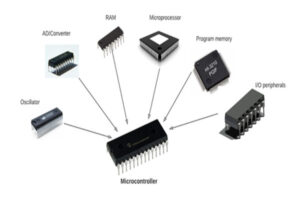Many contemporary electronic systems are controlled by tiny, potent microcontrollers. These integrated circuits are tiny devices, but they are packed with a processor, memory, and input/output (I/O) peripherals that enable them to handle a wide range of jobs and sophisticated instructions.
In today’s world of technology, microcontroller devices are used in everything from industrial machinery to wearables, automobile systems to home appliances. The basic principles of microcontrollers, their uses, and their revolutionary influence on technology are all examined in this article.
Anatomy of a Microcontrollers
One kind of microprocessor made especially for embedded systems is the microcontroller. It incorporates a number of crucial elements:
- Central Processing Unit (CPU): The microcontroller’s central processing unit (CPU) runs programs stored in the program memory. It may be built on any number of architectures, including PIC, AVR, and ARM.
-
Memory: Typically, microcontroller devices have non-volatile memory (Flash or EEPROM) for storing program code and permanent data, as well as volatile memory (RAM) for temporary data storage.
- I/O Peripherals: These consist of clocks, counters, digital and analog interfaces, and communication modules (such as SPI, I2C, and UART). The microcontroller can communicate with external sensors and devices thanks to these peripherals.
- Power Management: Efficient power management is crucial, especially in battery-operated applications. Many microcontroller devices have built-in features to manage power consumption, including sleep modes and low-power states noted Transparency Market Research.
Applications of Microcontroller Devices
Microcontrollers are used in a wide range of industries and applications. Among the most popular applications are:
- Consumer Electronics: Microcontroller devices are essential to the operation and maintenance of user interfaces in many devices, including televisions, cellphones, and household appliances. A microcontroller, for example, is used in microwave ovens to regulate user inputs, power levels, and cooking times.
-
Automotive Systems: Numerous microcontroller devices are used in modern cars for entertainment, airbag deployment, anti-lock braking systems (ABS), and engine control. These microcontrollers improve the user experience, safety, and performance of vehicles.
- Industrial Automation: Microcontrollers are essential to automation and control systems in the industrial industry. They oversee equipment, process management, and data collection, which improves accuracy and efficiency.
-
Medical Devices: A wide variety of medical devices, from straightforward ones like digital thermometers to intricate ones like insulin pumps and MRI scanners, are powered by microcontrollers. In crucial health applications, they provide reactivity, precision, and dependability.
- IoT Devices: A wide variety of medical devices, from straightforward ones like digital thermometers to intricate ones like insulin pumps and MRI scanners, are powered by microcontrollers. In crucial health applications, they provide reactivity, precision, and dependability.
The Impact of Microcontrollers on Technology
Microcontrollers have revolutionized technology in several key ways:
- Miniaturization: The creation of small, portable gadgets is made possible by the integration of several functionalities onto a single chip. Smartwatches and fitness trackers and other wearable electronics have been made possible by this shrinking.
-
Cost Efficiency: Because microcontroller devices are reasonably priced, the cost of electronic devices is reduced overall. Because of its cost, modern technology is now more widely available to a wider public, democratizing access to it.
- Energy Efficiency: Microcontroller devices help create devices that are more energy-efficient because of their sophisticated power management features. In battery-powered applications, where extending battery life is essential, this is especially significant.
-
Customization and Flexibility: Developers can tailor the functionality of programmable microcontroller devices to meet unique requirements. The development of specific applications for a variety of sectors requires this versatility.
- Enhanced Functionality: By integrating various peripherals and interfaces, microcontrollers can handle multiple tasks simultaneously. This capability has led to the development of multifunctional devices, enhancing user convenience and experience.
Future Trends and Innovations
The future of microcontrollers promises even greater advancements and innovations. Key trends include:
- Increased Processing Power: Ongoing developments aim to enhance the processing power of microcontroller devices while maintaining low power consumption. This will enable more complex applications and improved performance.
-
Advanced Connectivity: The proliferation of IoT devices requires microcontroller devices with robust connectivity options, including advanced wireless protocols like 5G, Bluetooth Low Energy (BLE), and LoRa.
- Artificial Intelligence (AI) Integration: Future microcontrollers are expected to incorporate AI and machine learning capabilities, enabling smarter and more autonomous systems. This integration will be pivotal in applications like predictive maintenance and autonomous vehicles.
-
Security Enhancements: As devices become more interconnected, security becomes paramount. Innovations in microcontroller design will focus on enhancing cybersecurity features to protect against threats and vulnerabilities.
- Eco-Friendly Design: Sustainable development is a growing priority, leading to the design of eco-friendly microcontrollers with lower environmental impact, including the use of biodegradable materials and energy-efficient manufacturing processes.
These insights are based on a report on Microcontrollers Market by Transparency Market Research




